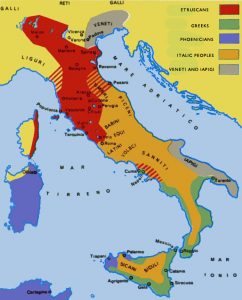
THE ETRUSCANS, THE GREEKS AND THE PHOENICIANS
In the eighth century BC, the Italian peninsula, except for the Southern part, where the Greeks began to found colonies (Cuma in the second half of the eighth century BC, Sybaris at the end of the eighth century BC, as well as a few others), was inhabited by the so-called Italic peoples: Latins, Umbrians, Sabines, Piceni, Samnites, Iapigi, Messapi, Equi, Veneti, Liguri, etc., where the economic and cultural influence of the Etruscans was strong. The Italian territory was composed of a network of indigenous villages. (1)
For a mere academic schematization, we can outline 3 models of occupation of the Italian territory, which were applied by the Etruscans, Greeks and Phoenicians.
ETRUSCAN MODEL: The Etruscans, with their arrival, favored new forms of urbanization by aggregating small scattered villages. Thus the so-called “Etruscan synoecism” takes place: this term indicates the process of unification (2). A probable example was Pompeii, where the mythical people of Sarrastri, who previously lived on the banks of the Sarno river in villages of huts, were urged by the Etruscans to “unify” by founding the famous town of Campania.
GREEK MODEL: The other model is the one that spread in Southern Italy, “Magna Graecia” [and Sicily ed.], where the urbanization process was the opposite, because it started from a global vision of the urban planning. (3)The Greek settlers considered the “fertile soil” as the most important criteria in the selection of the site, since in most cases, to look for new lands to be cultivated, they had abandoned the motherland, afflicted by the increase in population, by the low quantity of production and quality of its soils (poor, being superficial and stony) and their intensive exploitation, which lasted for centuries. (4)Therefore this will determine the acquisition, sometimes violent, of the land at the expense of the natives. (5) Archaeological research has almost always documented that the Greeks systematically destroyed the indigenous villages in order to establish their settlements in Magna Graecia and Sicily.
PHOENICIAN MODEL: The Phoenicians tended only to found emporiums for their trade with the local populations, with whom they usually entertained peaceful relations. (6). A notable exception is Carthage, which, in its long history, assumed a hegemonic role in the western Mediterranean. It maintained its great power until the time when, in the III century B.C., it clashed with Rome (Punic Wars).
BIBLIOGRAPHY:
- Giuseppe Gisotti, La fondazione delle città, Carocci Editore 2016 – pag. 26
- Ibid. p. 26
- Ibid. p. 26
- Ibid. p. 22
- Gioacchino Francesco La Torre, Sicilia e Magna Grecia, Editori Laterza, 2011, p. 24
- Giuseppe Gisotti, op. cit. p. 20





Leave a Reply
Want to join the discussion?Feel free to contribute!